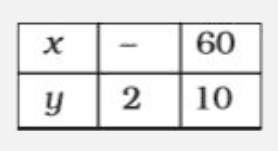The variable x is inversely proportional to y. If x increases by p%, then by what per cent will y decrease?
To solve the problem where the variable x is inversely proportional to y, and we need to determine the percentage decrease in y when x increases by p%, we can follow these steps:
1. Understanding Inverse Proportionality:
- Since x is inversely proportional to y, we can express this relationship mathematically as:
x∝1y
- This means that x×y=k, where k is a constant.
2. Expressing the Relationship:
- We can rewrite the proportionality as an equation:
x×y=k
3. Effect of Increasing x:
- If x increases by p%, the new value of x can be expressed as:
x′=x+p100×x=x(1+p100)
4. Finding the New Value of y:
- Let the new value of y be y′. Since the product x′×y′=k, we can write:
x′×y′=k
- Substituting the expression for x′:
x(1+p100)×y′=k
5. Relating the New and Old Values:
- Since x×y=k, we can replace k in the equation:
x(1+p100)×y′=x×y
- Dividing both sides by x:
(1+p100)×y′=y
6. Solving for y′:
- Rearranging gives:
y′=y1+p100
7. Finding the Percentage Decrease in y:
- The decrease in y can be calculated as:
Decrease=y−y′=y−y1+p100=y⎛⎝1−11+p100⎞⎠
- Simplifying this expression:
Decrease=y⎛⎝(1+p100)−11+p100⎞⎠=y⎛⎝p1001+p100⎞⎠
8. Calculating the Percentage Decrease:
- The percentage decrease in y is then given by:
Percentage Decrease=Decreasey×100=p1001+p100×100=p1+p100
Final Answer:
Thus, if x increases by p%, y will decrease by:
p1+p100×100%
- Since x is inversely proportional to y, we can express this relationship mathematically as:
x∝1y
- This means that x×y=k, where k is a constant.
- We can rewrite the proportionality as an equation:
x×y=k
- If x increases by p%, the new value of x can be expressed as:
x′=x+p100×x=x(1+p100)
- Let the new value of y be y′. Since the product x′×y′=k, we can write:
x′×y′=k
- Substituting the expression for x′:
x(1+p100)×y′=k
- Since x×y=k, we can replace k in the equation:
x(1+p100)×y′=x×y
- Dividing both sides by x:
(1+p100)×y′=y
- Rearranging gives:
y′=y1+p100
- The decrease in y can be calculated as:
Decrease=y−y′=y−y1+p100=y⎛⎝1−11+p100⎞⎠
- Simplifying this expression:
Decrease=y⎛⎝(1+p100)−11+p100⎞⎠=y⎛⎝p1001+p100⎞⎠
- The percentage decrease in y is then given by:
Percentage Decrease=Decreasey×100=p1001+p100×100=p1+p100
Thus, if x increases by p%, y will decrease by:
p1+p100×100%
Topper's Solved these Questions
- DIRECT AND INVERSE PROPORTIONS BOOK - NCERT EXEMPLARCHAPTER - DIRECT AND INVERSE PROPORTIONS EXERCISE - THINK AND DISCUSS
2 Videos
- DIRECT AND INVERSE PROPORTIONS BOOK - NCERT EXEMPLARCHAPTER - DIRECT AND INVERSE PROPORTIONS EXERCISE - THINK AND DISCUSS
2 Videos
- DATA HANDLINGBOOK - NCERT EXEMPLARCHAPTER - DATA HANDLINGEXERCISE - EXERCISE
73 Videos
- EXPONENTS AND POWERSBOOK - NCERT EXEMPLARCHAPTER - EXPONENTS AND POWERSEXERCISE - EXERCISE
195 Videos
Similar Questions
Knowledge Check
Two positive numbers x and y are inversely proportional. If x is increased by 10%, then y will be decresed by:
A10011%B1011%C10%D211%Two positive numbers x and y are inversely proportional . If x increases by 10% then y decreases by
A10%B211%C10011%D1011%Two positive numbers x and y are inversely proportional. If x increases by 10%, then y decreases by
A10011%B1011%C0.1D211%
If x varies inversely as y, then

View SolutionTwo positive numbers x and y are inversely proportional. If x increases by 10%, then y decreases by
View SolutionIf X is 90% of y then what percent of X is Y? 90% b. 10119% c. 11 19 % d. 190%
View Solutionx is inversely proportional to square of y, when x = 4, then y = 3 . Find x , if y=6
View SolutionFind the third proportional to (x2−y2) and (x+y)
View Solution
